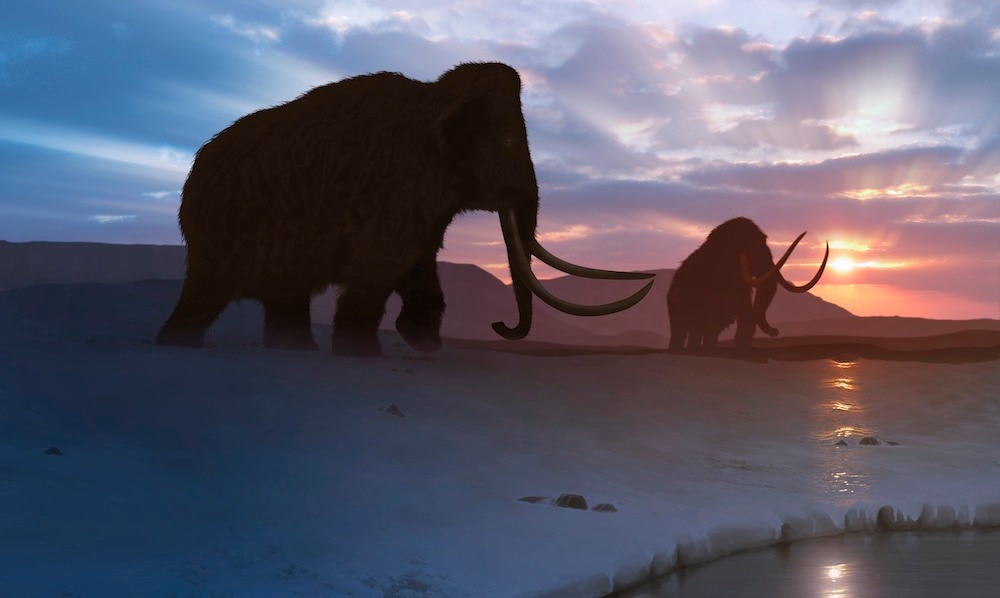Create a free profile to get unlimited access to exclusive videos, sweepstakes, and more!
Woolly mammoths were probably around much longer than we thought
Woolly mammoths didn't go extinct when they vanished from the fossil record, but much later.

While the de-extinction of woolly mammoths isn’t happening anytime soon, turns out they were around for longer than anyone previously thought.
It seemed that woolly mammoths went extinct when they vanished from the fossil record, but now there is evidence they were still trampling through the snow thousands of years later. Researcher Tyler Murchie of McMaster University in Canada, who led a study recently published in Nature Communications and another in Communications Biology, found mammoth DNA preserved in permafrost. The creatures would shed cells that went into a deep freeze.
“Most of this shed environmental DNA will be broken down or metabolized by bacteria, but a tiny fraction ends up binding to minerals or forming other molecular complexes which preserves those fragments of DNA long term, in this case for tens of millennia,” Murchie told SYFY WIRE.
You would only need to set your time machine back about 5,700 years to see a mammoth for yourself. Murchie and his team were able to isolate the sedaDNA, or sedimentary ancient DNA, from bacteria and everything else in those samples to prove mammoths really were still alive long after the last one was thought to have breathed its last. Ancient DNA is fragile and often fragmented. This is why the researchers used capture enrichment, which involves RNA-baiting chemicals designed to bind to the genomes of only the organisms they were interested in.
More DNA could also be sequenced with capture enrichment. Combining that with better methods of extraction allowed the team to reconstruct the ecosystems that were once dominated by herds of mammoths. Additional data has surfaced since then, an update that appears in the later study. There was enough mammoth DNA to reconstruct five mitogenomes, or mitochondrial genomes. The mitochondrial genome is all the genetic information carried by the mitochondria of the cell, which (among other things) are responsible for many energy processes. These genomes show evidence of hybridization that resulted from the interbreeding between different mammoth species. One particular species is now thought to be a hybrid.
“We also used supercomputers to compare those sequenced fragments against all other known reference DNA,” said Murchie. “This was done to determine which piece is likely to belong to which lineage of organisms, with varying degrees of specificity depending on which part of the genome a fragment came from.”
Radiocarbon dating determined the age of the samples, and the youngest containing mammoth DNA were about 5,700 years old. Eurasian mammoth DNA was also found in the permafrost, which meant that Eurasian lineages of the same species found their way over to North America somehow. Samples were carefully examined and reexamined. Murchie and his team needed to make sure that they were representations of unadulterated material that accumulated over hundreds of years without disruptions, and even from different animals, though we will never really know whether any minor changes potentially hidden in the samples were not showing up.
Using genetic mapping and other techniques untangled most of the DNA belonging to several haplogroups in the samples. Haplogroups are identified by closely related alleles, or alternative forms of a gene that arise from mutation and are found in the same area of a chromosome. This means that individuals from a population with this gene share a common ancestor. Murchie thinks they could have survived even longer under the right conditions, which may still give critically endangered species a more optimistic outlook.
“I think this helps show that animals can persist through genetic bottlenecks for millennia,” he said. “Perhaps if humans had not been around and there was another glacial period, these animals may have rebounded much as they had during numerous previous glacial-interglacial-glacial transitions. This gives some hope to critically endangered animals today.”
Mammoths only remain as fur and bones. If we can reverse the destruction we have caused to the habitats of extant endangered species before they vanish forever, at least they might be able to make a comeback.


























